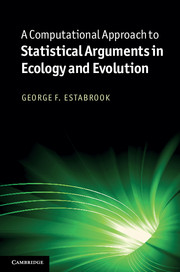Book contents
- Frontmatter
- Contents
- Acknowledgments
- 1 Introduction
- 2 Programming and statistical concepts
- 3 Choosing a test statistic
- 4 Random variables and distributions
- 5 More programming and statistical concepts
- 6 Parametric distributions
- 7 Linear model
- 8 Fitting distributions
- 9 Dependencies
- 10 How to get away with peeking at data
- 11 Contingency
- References
- Index
2 - Programming and statistical concepts
Published online by Cambridge University Press: 05 June 2012
- Frontmatter
- Contents
- Acknowledgments
- 1 Introduction
- 2 Programming and statistical concepts
- 3 Choosing a test statistic
- 4 Random variables and distributions
- 5 More programming and statistical concepts
- 6 Parametric distributions
- 7 Linear model
- 8 Fitting distributions
- 9 Dependencies
- 10 How to get away with peeking at data
- 11 Contingency
- References
- Index
Summary
History
In the late nineteenth and early twentieth century, computing devices became more powerful when they were provided with memory in which to store the data used in the computation. This memory could also store the intermediate results of computation for later use. In the middle of the twentieth century, a major breakthrough in the design of computers occurred when scientists realized that the memory of a computing device could also store the computational instructions themselves. This enabled programmers to compose computational instructions that could be executed automatically, without human intervention.
The instructions that a computer can execute directly need to be very detailed; they are tedious and time consuming to compose, difficult to read even for experienced programmers, prone to errors, and hard to correct. In the late 1950s, some people in the IBM Corporation realized that they could write a computer program that could read statements in a language in which a computer programmer could express his or her intent more efficiently, and then translate those statements into the detailed instructions that a computer can execute directly. We call such a translating program a compiler. Before a compiler can be written, the programming language that it translates, i.e., vocabulary, syntax, and grammar, must be explicitly specified. The program that a compiler translates is called the source statements or source code. When a compiler executes to translate source statements it is said to compile the source statements. The result of a compilation is the object code. Object code is another computer program written with the instructions that the computer can execute directly. When a programmer writes a program in a source language, first source statements are composed using an editor, next those source statements are compiled into object code, and finally that object code is executed to carry out the intent of the programmer. We often use the simpler term, run, to mean execute.
- Type
- Chapter
- Information
- Publisher: Cambridge University PressPrint publication year: 2011

